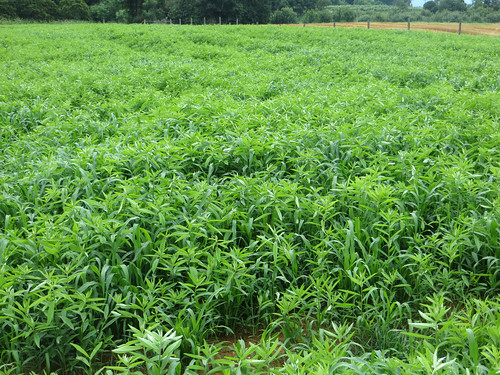For the past two weeks, the goats have had access to a paddock containing a mixture of dwarf pearl millet (warm season grass) and Sunn Hemp (warm season legume). Though they were slow to graze it initially, they have now consumed almost all of the Sunn Hemp (leaves) and are now grazing down the millet. Tomorrow, they will be moved to a field that was planted in millet and cow peas (another warm season legume).
On July 18, fresh forage samples were collected from the paddocks that the goats have been grazing for the past two weeks. They were analyzed for nutritive content by Cumberland Valley Analytical Services.
Explanation of forage analysis
Dry matter (DM) is the air-dried component of the feedstuff with all the moisture removed. Animals use nutrients on a dry matter basis. CP (crude protein) is based on the nitrogen content of the feed. It is 6.25 times the nitrogen content.
Neutral detergent Fiber (NDF) represents the total fiber content of the feedstuff. As NDF increases, intake is expected to decline. Acid detergent fiber (ADF) is the value that corresponds to the level of cellulose and lignin in the plant. Lignin is considered indigestible. ADF is an estimation of the component of the feedstuff that is indigestible. The greater the ADF value, the more indigestible the feedstuff.
Total digestible nutrients (TDN) is an estimate of the energy content of the feed or roughage. Typically, the greater the value, the more energy dense the feedstuff is considered. Relative Feed Value (RFV) is an index that ranks forages on NDF and ADF, as compared to full-bloom alfalfa which is assigned an RFV of 100.
Source: Interpreting forage and feed analysis reports
Energy supplementation
The bucks continue to be supplemented with soybean hulls. They are currently consuming approximately 0.5 lbs. per head per day (approximately 1% of their body weight). The data received from the Animal Grazing Lab (in Texas) supports the wisdom of supplemental feeding of soy hulls (energy).
On July 18, fresh forage samples were collected from the paddocks that the goats have been grazing for the past two weeks. They were analyzed for nutritive content by Cumberland Valley Analytical Services.
Dry matter (DM) is the air-dried component of the feedstuff with all the moisture removed. Animals use nutrients on a dry matter basis. CP (crude protein) is based on the nitrogen content of the feed. It is 6.25 times the nitrogen content.
Neutral detergent Fiber (NDF) represents the total fiber content of the feedstuff. As NDF increases, intake is expected to decline. Acid detergent fiber (ADF) is the value that corresponds to the level of cellulose and lignin in the plant. Lignin is considered indigestible. ADF is an estimation of the component of the feedstuff that is indigestible. The greater the ADF value, the more indigestible the feedstuff.
 |
| Sunn Hemp + Dwarf Pearl Millet |
Total digestible nutrients (TDN) is an estimate of the energy content of the feed or roughage. Typically, the greater the value, the more energy dense the feedstuff is considered. Relative Feed Value (RFV) is an index that ranks forages on NDF and ADF, as compared to full-bloom alfalfa which is assigned an RFV of 100.
Source: Interpreting forage and feed analysis reports
Energy supplementation
The bucks continue to be supplemented with soybean hulls. They are currently consuming approximately 0.5 lbs. per head per day (approximately 1% of their body weight). The data received from the Animal Grazing Lab (in Texas) supports the wisdom of supplemental feeding of soy hulls (energy).












